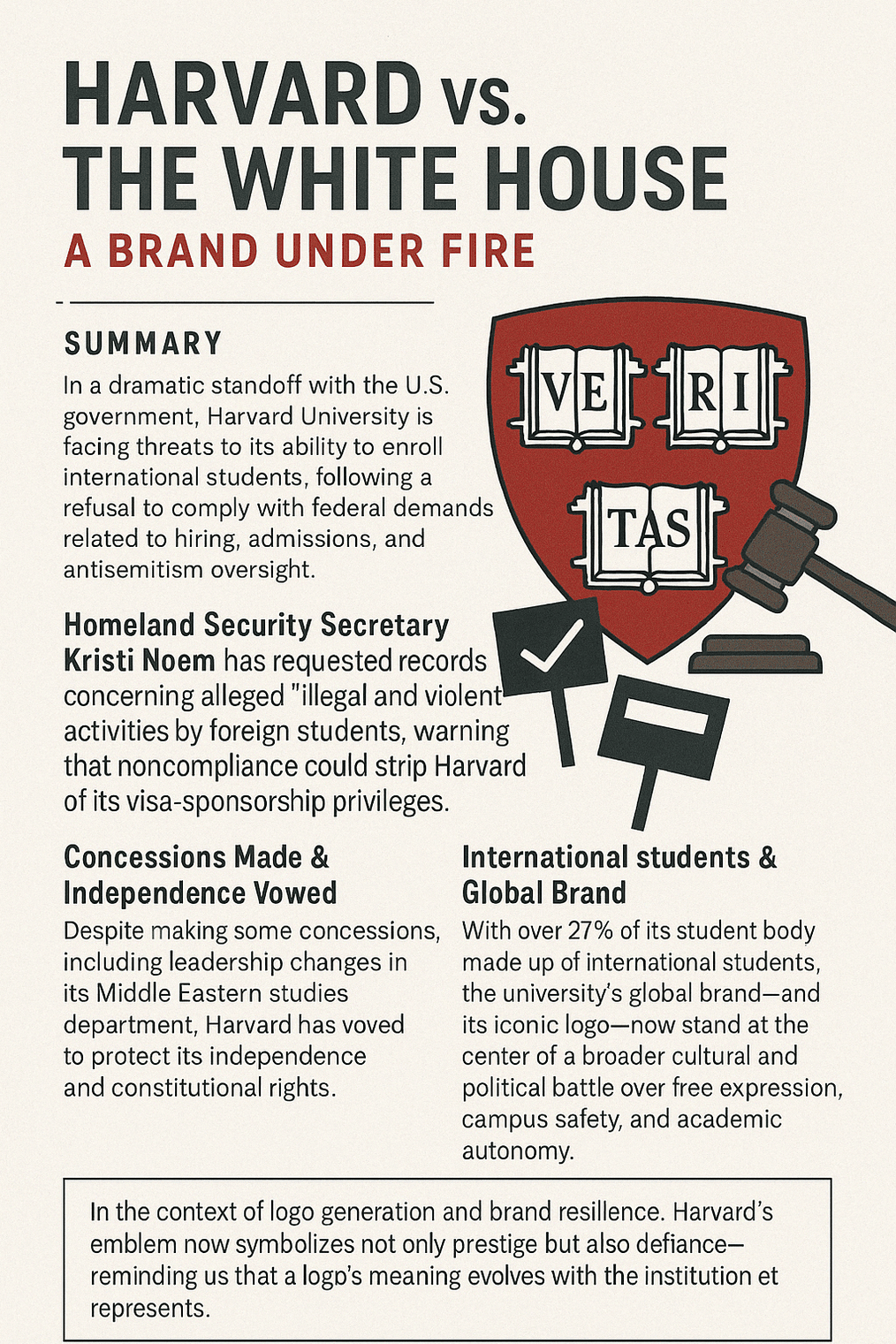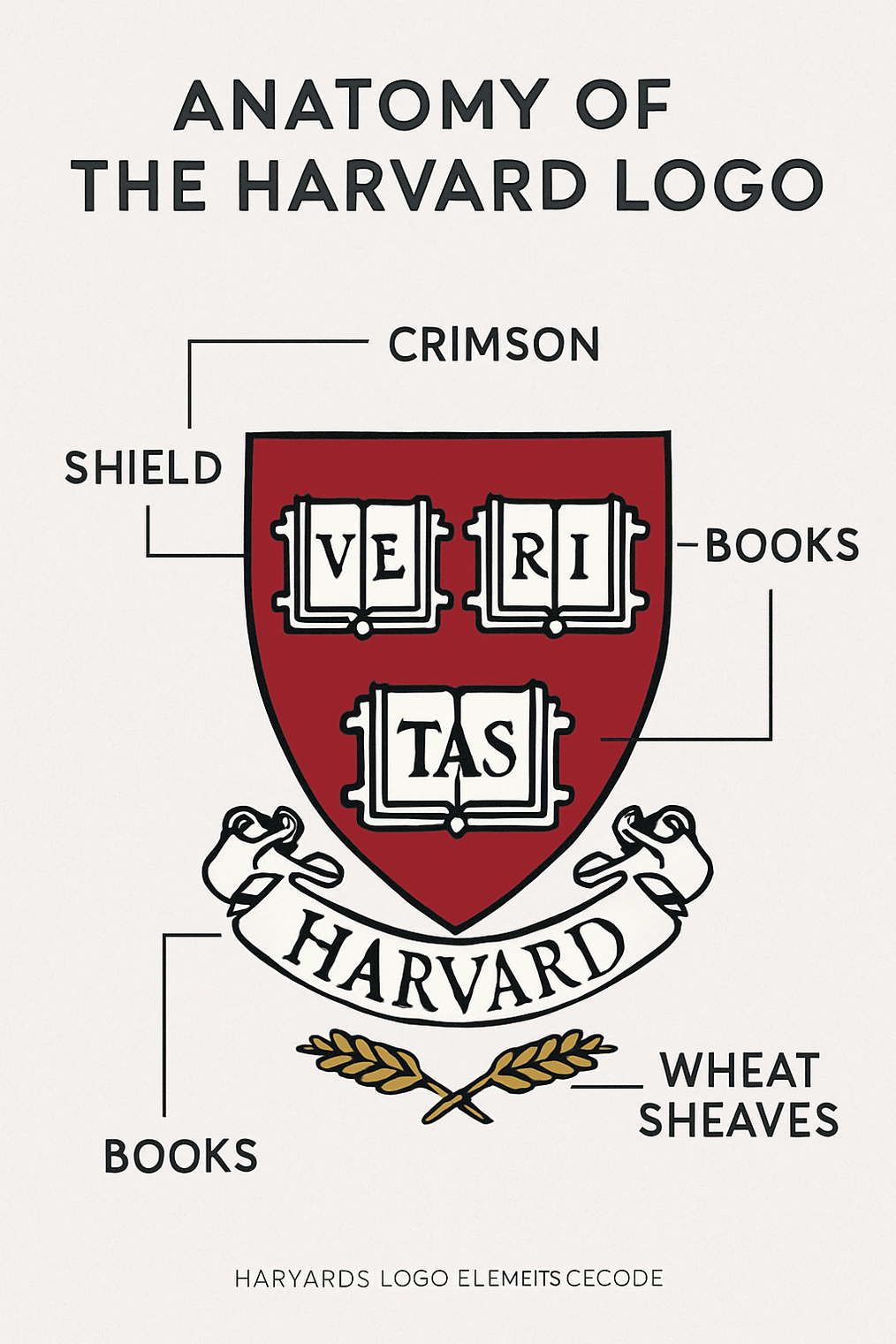In the hallowed halls of academia, few symbols carry the weight of Harvard University’s logo. But beyond tradition lies a masterclass in branding, storytelling, and design—offering timeless inspiration for anyone using a logo maker, exploring logo generation, or experimenting with an AI logo generator.
From its historical roots to its modern-day resonance, the Harvard logo is a masterclass in branding, artistry, and storytelling. In this deep dive, we’ll explore the logo’s birth, dissect its design anatomy, and unravel its cultural impact—sprinkling in a touch of wit and a nod to modern tools like AI logo generators that make logo generation more accessible than ever. Buckle up for a 2,500-word journey through time, color, and controversy.
The Birth of an Icon: How Harvard’s Logo Came to Be
Picture it: 1636, Massachusetts Bay Colony. Harvard College is founded—a fledgling institution with oversized dreams. But it wasn’t until 1843 that the university formalized its seal, a shield inspired by the coat of arms of founder John Harvard’s family. The design was practical yet profound—a red shield with three open books, each bearing the letters VE-RI-TAS. It was a declaration of purpose: the pursuit of truth, no matter how inconvenient.
The logo’s origins are steeped in heraldry, a visual language of the elite. “Heraldic shields were the medieval equivalent of a corporate logo,” says Dr. Eliza Thornton, a historian of academic iconography. “They signaled lineage, authority, and permanence—qualities Harvard wanted to project.” Unlike today’s tools where a logo maker or AI logo generator can deliver concepts in seconds, crafting Harvard’s seal was a meticulous process, debated by scholars and etched by hand.
By the 19th century, the seal evolved. The shield’s elements—books, wheat sheaves, and crimson hues—were refined to match Harvard’s academic prestige. By the 20th century, the symbol transcended function. It became a global brand, printed on sweatshirts, etched into diplomas, and embedded in the aspirations of generations.
Pro Tip: Want your own historic-inspired brand mark? An AI logo generator like Looka or Brandmark can emulate timeless elegance in seconds, making logo creation accessible for any modern institution.
Color Psychology: Why Crimson Reigns Supreme
Let’s talk about crimson—Harvard’s signature hue. In color psychology, red is linked to passion, power, and authority. Crimson, a deeper red, elevates that with added richness and tradition.
Legend has it, the rowing team wore crimson scarves during an 1858 regatta. The color stuck. Today, crimson isn’t just branding—it’s identity. It’s been used consistently in every Harvard logo generation, reinforcing brand trust and recognition.
“Crimson isn’t just a color; it’s a message,” says color theorist Lila Voss. “It commands attention and evokes reverence.”
While free AI logo creator tools can generate varied palettes, the key lies in consistency. Harvard’s mastery of crimson across digital and print media proves that color is more than aesthetic—it’s strategy.
Artistry and Design Patterns: A Study in Simplicity
At first glance, Harvard’s logo is modest: a shield, three books, one Latin word. But simplicity is often the pinnacle of sophistication.
The logo’s beauty lies in its restraint. Geometric precision brings balance. Open books symbolize intellectual inquiry. Wheat sheaves whisper prosperity and community. It’s ancient and modern in equal measure.
While some AI logo generators create cluttered or overly ornate designs, Harvard’s shield shows that minimalist logos can pack the biggest punch. For your next branding attempt, let a logo maker guide you—but let restraint win the day.
Controversies: When a Logo Sparks Debate
Even a revered emblem can stir debate. In 2016, Harvard faced calls to remove parts of its logo associated with a slaveholding benefactor. This ignited wider conversations about historical accountability.
Should a logo evolve with values or remain untouched? Harvard chose nuance. The main seal stayed, but the law school’s controversial crest was retired.
This episode underscores the responsibility embedded in logo generation. Whether you’re using an AI logo generator or a design agency, symbols are never neutral. A logo’s cultural context matters—deeply.
In a dramatic standoff with the U.S. government, Harvard University is facing threats to its ability to enroll international students, following a refusal to comply with federal demands related to hiring, admissions, and antisemitism oversight. Homeland Security Secretary Kristi Noem has requested records concerning alleged “illegal and violent” activities by foreign students, warning that noncompliance could strip Harvard of its visa-sponsorship privileges.
The controversy follows a $2.2 billion funding freeze and threats from former President Donald Trump to revoke Harvard’s tax-exempt status—moves many critics view as politically motivated. Despite making some concessions, including leadership changes in its Middle Eastern studies departments, Harvard has vowed to protect its independence and constitutional rights.
With over 27% of its student body made up of international students, the university’s global brand—and its iconic logo—now stand at the center of a broader cultural and political battle over free expression, campus safety, and academic autonomy.
🧠 In the context of logo generation and brand resilience, Harvard’s emblem now symbolizes not only prestige but also defiance—reminding us that a logo’s meaning evolves with the institution it represents.

The Logo’s Role in Defining Eras
A powerful logo captures time. Harvard’s did just that. In the 1800s, it was a symbol of budding academia. In the 20th century, it stood for global intellectual dominance. Today, it’s a digital avatar—resized for Instagram, LinkedIn, and MOOCs.
Each generation added layers of meaning. Protesters in the 1960s carried banners adorned with the logo. In the 2000s, it became a merchandising empire. Harvard’s crimson shield now exists in pixels, memes, and NFTs.
Lesson: A great logo isn’t frozen in time—it evolves. When using an AI logo generator, design for legacy and longevity.
Design Lessons from Harvard’s Logo
What can startups and creators learn from Harvard?
- Simplicity Wins: Minimal designs, like Harvard’s, are memorable and scalable.
- Color Consistency Matters: Crimson wasn’t chosen randomly; it’s the soul of the brand.
- Storytelling Is Key: Each element—from books to wheat—tells a story. Yours should too.
Whether you’re using a high-end logo maker or a free AI logo generator without watermark, remember: your logo is your silent ambassador.
Symbolism: Decoding the Shield
Let’s unpack the elements.
- Shield: Evokes strength and lineage.
- Books: Open for inquiry—symbolizing education.
- Wheat: Prosperity and growth.
- Veritas: A bold motto in an age of spin.
These elements aren’t just decorative—they speak to Harvard’s mission. And while AI logo generation may not embed symbolism automatically, you can guide it with prompts that infuse meaning.
Impact on Society: A Logo That Shapes Culture
Harvard’s logo isn’t confined to academia. It’s in movies, memes, novels. It’s shorthand for “elite institution.” In The Social Network, the logo becomes a character. In Suits, it’s synonymous with ambition.
But it also has real economic weight. Harvard earns millions annually from logo licensing. It’s the Nike swoosh of higher education.
This influence shows what a logo can become. Start with an AI logo generator, but aim to build cultural capital.
Logo Modernism: A Beacon of Timeless Design
Harvard’s logo is a modernist masterpiece. Clean lines. Bold fonts. Geometric balance. It avoids gradients, sparkles, and complexity.
This restraint sets it apart from many early-2000s logos that drowned in effects. In an era of minimalism, Harvard was ahead of the curve.
Modern logo makers like Logo Diffusion or Kittl now embrace this ethos, allowing anyone to create crisp, modern logos inspired by timeless principles.
Principles of Logo Design: Harvard’s Blueprint
Here’s how Harvard’s logo aligns with the pillars of great logo design:
- Clarity: Instantly identifiable.
- Versatility: Works on hoodies, headers, and Harvard Law briefs.
- Memorability: Crimson + Veritas = unforgettable.
- Timelessness: Designed in the 1800s. Relevant in 2025.
For AI logo generator users, this blueprint is gold. Feed your tool these principles, and watch your brand’s future unfold.
Brand Identity: The Power of Consistency
Harvard’s branding is disciplined. The logo appears the same—whether in Harvard Yard or HarvardX. That visual uniformity builds trust.
Their strict brand guidelines ensure that the logo, font, and color are never misused.
Consistency is where many DIY logo generation efforts fall short. Using a free AI logo creator tool is fine—but lock in your branding elements and don’t deviate.
Design Anatomy: Breaking Down the Elements
A quick breakdown:
- Shield: Strength, tradition.
- Books: Curiosity, learning.
- Wheat Sheaves: Nourishment, growth.
- Crimson: Emotional depth.
- Veritas: The truth—pure and unadorned.
Each of these can be instructive when building your own logo. Don’t treat your AI-generated design as finished art—treat it as the start of a story.
Messaging: What the Logo Says Without Words
Harvard’s logo isn’t just visual—it’s verbal, too. It says:
- “We’re old, but still relevant.”
- “We’re serious, but not inaccessible.”
- “We are about truth.”
Every element is aligned with this message. As you generate your own logo using AI, ask: What’s my logo saying without words?
Hashtag History: The Logo in the Digital Age
In the social age, #HarvardProud and #Veritas help the logo circulate globally. Whether it’s commencement or casual Friday, that crimson crest goes viral.
And because it scales so well, it performs beautifully in digital environments—something modern logo generators prioritize.
Want similar performance? Use a logo maker that optimizes for digital use—vector files, transparent backgrounds, and scalable SVGs.
Growth: From Campus to Global Brand
Harvard’s logo started as a college seal. Now, it’s a global powerhouse. It appears on coffee mugs, online courses, and high-stakes negotiations.
That’s the arc every logo should aim for—from niche to iconic.
Even if you start with a free AI logo generator, think like a global brand. Design with expansion in mind.
Impact of Technology: Logos in the AI Era
Once upon a time, logos were carved, printed, inked. Today? Logo generation takes minutes, thanks to tools like LogoAI, Turbologo, or Designs.ai.
AI logo generators democratize branding. But great logos still require human judgment acting like a logo maker.
The Harvard logo was made in an analog age, but it thrives in the digital one. That’s your north star—tech-enhanced, but story-driven.
Conclusion: A Logo for the Ages
Harvard’s logo is more than design—it’s doctrine. Its symbolism, colors, and legacy form the perfect case study in timeless branding.
So next time you ask, “How do I make a logo?”—whether with a free AI logo generator or a custom design studio—look to the crimson shield.
If your design tells a story, carries meaning, and outlasts trends, you’re not just making a logo. You’re building a legacy.
